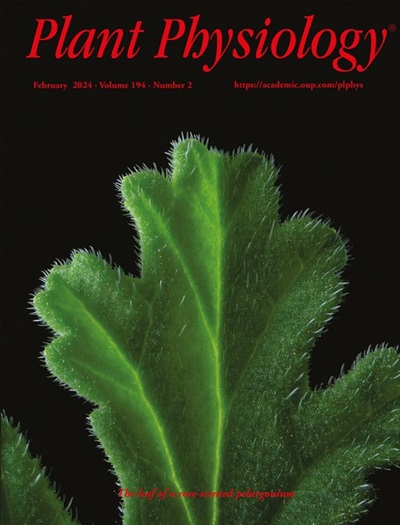甘蔗中晚熟初级脱羧酶 C4NADP-ME 的调控网络
IF 6.5
1区 生物学
Q1 PLANT SCIENCES
引用次数: 0
摘要
在具有重要农艺价值的 C4 禾本科植物中,NADP-苹果酸酶(C4NADP-ME)有助于将二氧化碳有效地输送到 Rubisco,该酶可使束鞘细胞中的苹果酸脱羧。然而,甘蔗(Saccharum spp.)复杂的遗传背景阻碍了对 C4NADP-ME 基因分子调控的了解。酶活性测定表明,甘蔗(Saccharum spontaneum)的脱羧主要依赖于 NADP-ME 途径,这一点与高粱(Sorghum bicolor)和玉米(Zea mays)相似。比较基因组学分析表明,甘蔗的 C4 通路中招募了八个核心 C4 穿梭基因,其中包括 C4NADP-ME(SsC4NADP-ME2)。与高粱和玉米不同,甘蔗中 SsC4NADP-ME2 的表达受不同转录因子(TFs)的调控。我们提出了一个 SsC4NADP-ME2 的基因调控网络,其中包括通过基因共表达分析和酵母单杂交实验发现的候选 TFs。其中,ABA INSENSITIVE5(ABI5)被证实是 SsC4NADP-ME2 表达的主要调控因子,它与 SsC4NADP-ME2 启动子区域内的一个 G-box 结合。有趣的是,调控 G-box 中的核心元素 ACGT 在甘蔗、高粱、玉米和水稻(Oryza sativa)中都是保守的,这表明 C4 光合作用中使用了古老的调控代码。这项研究为 SsC4NADP-ME2 的调控提供了见解,这对优化甘蔗作为生物能源作物至关重要。本文章由计算机程序翻译,如有差异,请以英文原文为准。
Regulatory Network of the Late-Recruited Primary Decarboxylase C4NADP-ME in Sugarcane
In agronomically important C4 grasses, efficient CO2 delivery to Rubisco is facilitated by NADP-malic enzyme (C4NADP-ME), which decarboxylates malate in bundle sheath cells. However, understanding the molecular regulation of the C4NADP-ME gene in sugarcane (Saccharum spp.) is hindered by its complex genetic background. Enzymatic activity assays demonstrated that decarboxylation in sugarcane Saccharum spontaneum predominantly relies on the NADP-ME pathway, similar to sorghum (Sorghum bicolor) and maize (Zea mays). Comparative genomics analysis revealed the recruitment of eight core C4 shuttle genes, including C4NADP-ME (SsC4NADP-ME2), in the C4 pathway of sugarcane. Contrasting to sorghum and maize, the expression of SsC4NADP-ME2 in sugarcane is regulated by different transcription factors (TFs). We propose a gene regulatory network for SsC4NADP-ME2, involving candidate TFs identified through gene co-expression analysis and yeast one-hybrid experiment. Among these, ABA INSENSITIVE5 (ABI5) was validated as the predominant regulator of SsC4NADP-ME2 expression, binding to a G-box within its promoter region. Interestingly, the core element ACGT within the regulatory G-box was conserved in sugarcane, sorghum, maize, and rice (Oryza sativa), suggesting an ancient regulatory code utilized in C4 photosynthesis. This study offers insights into SsC4NADP-ME2 regulation, crucial for optimizing sugarcane as a bioenergy crop.
求助全文
通过发布文献求助,成功后即可免费获取论文全文。
去求助
来源期刊

Plant Physiology
生物-植物科学
CiteScore
12.20
自引率
5.40%
发文量
535
审稿时长
2.3 months
期刊介绍:
Plant Physiology® is a distinguished and highly respected journal with a rich history dating back to its establishment in 1926. It stands as a leading international publication in the field of plant biology, covering a comprehensive range of topics from the molecular and structural aspects of plant life to systems biology and ecophysiology. Recognized as the most highly cited journal in plant sciences, Plant Physiology® is a testament to its commitment to excellence and the dissemination of groundbreaking research.
As the official publication of the American Society of Plant Biologists, Plant Physiology® upholds rigorous peer-review standards, ensuring that the scientific community receives the highest quality research. The journal releases 12 issues annually, providing a steady stream of new findings and insights to its readership.
 求助内容:
求助内容: 应助结果提醒方式:
应助结果提醒方式:


